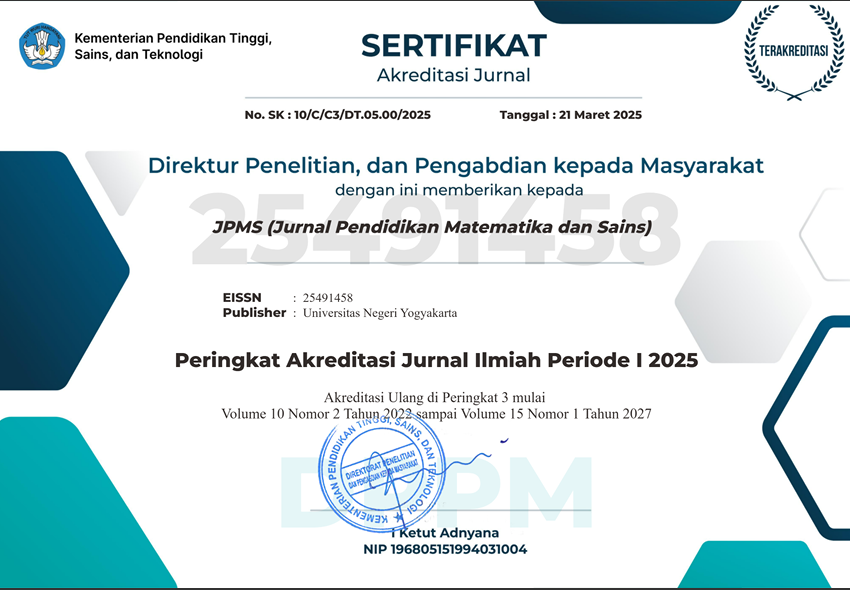Pengaruh Outdoor Learning Terhadap Kemampuan Berpikir Kritis Matematis Siswa
DOI:
https://doi.org/10.21831/jpms.v5i2.15482Keywords:
Outdoor, Learning, berpikir, kritisAbstract
References
Acar, H. (2014). Learning Environments for Children in Outdoor Spaces. Procedia - Social and Behavioral Sciences, 141, 846–853. https://doi.org/10.1016/j.sbspro.2014.05.147 Applebaum, M. (2015). Activating pre-service mathematics teachers' critical thinking. European Journal of Science and Mathematics Education, 3(1), 77–89. Ayazgí¶k, B., & Aslan, H. (2014). The Review of Academic Perception, Level of Metacognitive Awareness and Reflective Thinking Skills of Science and Mathematic University Students. Procedia - Social and Behavioral Sciences, 141, 781–790. https://doi.org/10.1016/j.sbspro.2014.05.137 Creswell, J. W. (2007). Research Design: Qualitative, Quantitative and Mixed Method Aproaches. SAGE Publications, 203–223. https://doi.org/10.4135/9781849208956 Das, S., Dewhurst, Y., & Gray, D. (2011). A Teacher's Repertoire: Developing Creative Pedagogies. International Journal of Education & the Arts, 12(15), 1–39. Ewert. A. W., & S. (2014). Outdoor Adventure Education (1st ed.). United States: Human Kinetics. Fägerstam, E., & Blom, J. (2013). Learning biology and mathematics outdoors: effects and attitudes in a Swedish high school context. Journal of Adventure Education & Outdoor Learning, 13(1), 56–75. https://doi.org/10.1080/14729679.2011.647432 Gustafsson, P. E., Szczepanski, A., Nelson, N., & Gustafsson, P. A. (2011). Effects of an outdoor education intervention on the mental health of schoolchildren. Journal of Adventure Education & Outdoor Learning, 12(1), 63–79. https://doi.org/10.1080/14729679.2010.532994 Husamah. (2013). Outdoor Learning (1st ed.). Jakarta: Prestasi Pustaka. Istianah, E. (2013). Meningkatkan Kemampuan Berpikir Kritis dan Kreatif Matematik Dengan Pendekatan Model Eliciting Activities (MEAS) pada Siswa SMA. Infinity, 2(1), 43–54. Kalaivani, K. & Tarmizi, R, A. (2014). Assessing Thinking Skills: A Case Of Problem-Based Learning In Learning Of Algebra Among Malaysian Form Four Students, 1, 8. Kloppers, M., & Grosser, M. (2014). The Critical Thinking Dispositions of Prospective Mathematics Teachers at a South African University : New Directions for Teacher Training. Int J Edu Sci, 7(3), 413–427. Mirrahmi, S. Z., Tawil, N. M., Abdullah, N. A. G., Surat, M., & Usman, I. M. S. (2011). Developing conducive sustainable outdoor learning: The impact of natural environment on learning, social and emotional intelligence. Procedia Engineering, 20, 389–396. https://doi.org/10.1016/j.proeng.2011.11.181 Peng, A., & Sollervall, H. (2014). Primary School Students' Spatial Orientation Strategies in an Outdoor Learning Activity Supported by Mobile Technologies. Online Submission. Retrieved from http://libezproxy.open.ac.uk/login?url=http://search.ebscohost.com/login.aspx?direct=true&db=eric&AN=ED548766&site=ehost-live&scope=site Piawa, C. Y. (2010). Building a test to assess creative and critical thinking simultaneously. Procedia - Social and Behavioral Sciences, 2(2), 551–559. https://doi.org/10.1016/j.sbspro.2010.03.062 Shamsuar, N. R. (2014). Game Design as a Tool to Promote Higher Order Thinking Skills. International Journal for Innovation Education and Research, 2(6), 51–58. Sudijono. A. (2012). Pengantar Statistik Pendidikan (1st ed.). Jakarta: Rajawali Pers. Syahbana, A. (2011). Peningkatan Kemampuan Berpikir Kritis Matematis Siswa SMP Melalui Pendekatan Contextual Teaching and Learning. Edumatica, 2(April), 45–57. Yildirim, B. (2011). The Critical Thinking Teaching Methods In Nursing Students. International Journal of Business and Social Science, 2(24), 174–182.
Downloads
Published
How to Cite
Issue
Section
Citation Check
License
Jurnal Pendidikan Matematika dan Sains allows readers to read, download, copy, distribute, print, search, or link to its articles' full texts and allows readers to use them for any other lawful purpose. The journal allows the author(s) to hold the copyright without restrictions. Finally, the journal allows the author(s) to retain publishing rights without restrictions
- Authors are allowed to archive their submitted article in an open access repository
- Authors are allowed to archive the final published article in an open access repository with an acknowledgment of its initial publication in this journal

This work is licensed under a Creative Commons Attribution-ShareAlike 4.0 Generic License.





